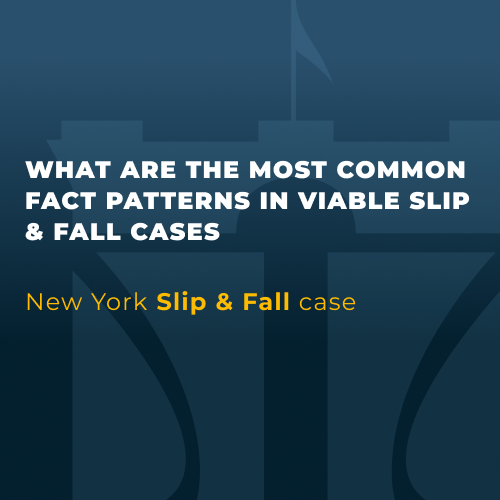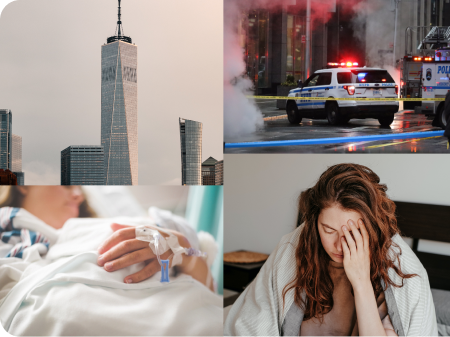
Slip and fall accidents are common personal injury claims in New York. Numerous dangerous conditions and hazards can cause you to lose balance and fall. Unfortunately, these claims are also challenging to pursue. Insurance companies often doubt the validity of slip-and-fall claims, resulting in the need to file a lawsuit. If you sustained injuries in a slip and fall, contact Anthony A. Ferrante today. Mr. Ferrante has years of experience assisting injured victims following a slip-and-fall accident.
Reasons Insurance Companies Deny Slip-and-Fall Claims
Insurance companies often deny slip-and-fall claims for lack of evidence. The adjuster might argue that the condition that caused the fall was obvious and that you should’ve taken steps to avoid the danger. They may also claim that the property owner took reasonable steps to fix the dangerous condition or that the slip and fall did not cause your injuries because they were preexisting. In some cases, insurance companies may try to dispute the extent of the injuries or the amount of medical expenses claimed.
Another reason insurance companies may deny slip-and-fall claims is due to allegations of fraud. Insurance fraud is a serious crime, and insurance companies take a zero-tolerance approach. The adjuster might investigate claims to ensure you didn’t stage the accident or exaggerate your injuries.
When an insurance adjuster suspects fraud, they may deny the claim outright or offer a lower settlement amount. In extreme cases, insurance fraud can result in criminal charges.
Common Types of Slip-and-Fall Accidents
Understandably, you likely have questions about what types of accidents can be viable slip-and-fall claims. The truth is any slip and fall that involves legitimate injuries could provide you reimbursement for your damages. Read on to learn more about common fact patterns in viable slip-and-fall cases.
Wet or Slippery Surfaces
One of the most common causes of slip-and-fall accidents is wet or slippery surfaces, such as spills or puddles. Property owners must clean up spills promptly and post warning signs when the floor is slick.
The question in this type of slip and fall is how long the ground was wet. For example, someone spilled something in a grocery store aisle, creating a hazardous condition. If the spill happened only minutes before, the store might not be liable. However, the owner could be responsible for your injuries if the store left the spill unattended for longer.
Uneven or Broken Surfaces
Another cause of slip-and-fall accidents is uneven or broken surfaces, such as cracked sidewalks or holes in the ground. Property owners must repair or replace damaged surfaces promptly to prevent accidents. Sidewalk injuries are more complicated because they involve public property. New York has sidewalk laws that state property owners are responsible for maintenance, shoveling snow, etc. However, the city could be liable for more extensive repairs if the property owner gave them written notice.
Poor Lighting
Poor lighting can also contribute to slip-and-fall accidents. Property owners must provide adequate lighting to ensure visitors can see where they are going, especially in areas with steps or changes in elevation.
Obstructions in Walkways
Obstructions, such as boxes, cords, or debris, can also cause slip and falls. Property owners must keep walkways clear to prevent accidents. Property owners may be liable for your injuries if they knew of the hazard and failed to remove the items or put up a warning sign.
Stairs in Disrepair
Loose railings or missing railings can also cause slip-and-fall accidents. Property owners must repair stairs to ensure their safety. Store owners should have warnings posted if there’s a problem with the staircase while awaiting repairs.
Rugs or Mats Without Slip-Resistant Backing
Rugs or mats that lack slip-resistant backing can cause devastating injuries in a fall. Property owners must adequately secure all carpets and rugs to prevent them from slipping or sliding.
Ice and Snow Accumulation
In New York, property owners are responsible for removing snow and ice from sidewalks and walkways within a reasonable amount of time after a storm. That requirement extends to stores and other places of business where visitors enter. If it snowed and someone immediately tracked water in, the store owner might not be liable. However, the owner could be responsible if the snow was hours earlier and no one cleaned the floors.
Proving Liability Against the Property Owner
To prove liability against a property owner in a slip and fall accident, the injured party must show that the property owner knew or should have known about the dangerous condition and failed to fix it. Successfully proving liability requires evidence, such as eyewitness testimony, photographs, and maintenance records.
Common Injuries in a Slip-and-Fall Accident
Slip-and-fall accidents can result in various injuries, including the following.
Sprains and Strains
Sprains and strains are common in slip and fall accidents. These injuries occur when a ligament or muscle is stretched or torn. Sprains and strains can result in pain, swelling, and difficulty moving the affected body part.
Broken Bones
Falls can result in broken bones, especially in older adults, who are more susceptible to bone fractures. Commonly broken bones from slip-and-fall accidents include wrist, ankle, and hip fractures.
Back Injuries
Back injuries, such as herniated discs, can also result from slip-and-fall accidents. These injuries can cause severe pain, numbness, and weakness in the arms or legs.
Head Injuries
Slip and falls can also result in head injuries, such as concussions or skull fractures. These injuries can be severe and can result in long-term symptoms, such as memory loss, difficulty concentrating, and mood changes.
Spinal Cord Injuries
In severe slip-and-fall accidents, victims can sustain spinal cord injuries. These injuries can cause permanent paralysis.
What to Do After a Slip-and-Fall Accident
The steps you take following a slip and fall are important. What you do and say can impact your injury claim. You should seek medical treatment right away if you do not require emergency medical assistance at the scene. Any delay in treatment will support the insurance company’s defense against compensating you. Be sure to report the accident right away if possible. That way, the store or business is on notice that an accident happened.
Do not exaggerate your injuries or make false statements to the insurance company, as this can result in severe consequences, including denial of your claim.
Contact a New York Slip-and-Fall Lawyer
Most slip and falls are real accidents and can result in serious injuries. If you suffered injuries, it is crucial to seek medical attention, report the incident to the property owner, and contact an experienced lawyer. Mr. Ferrante has over a decade of experience assisting victims of slip and falls in New York. Contact our office today to schedule an initial consultation to learn how we can help.

















